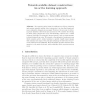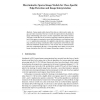1110 search results - page 87 / 222 » Neurocomputing for vision research |
ECCV
2008
Springer
14 years 11 months ago
2008
Springer
As computer vision research considers more object categories and greater variation within object categories, it is clear that larger and more exhaustive datasets are necessary. How...
ECCV
2008
Springer
14 years 11 months ago
2008
Springer
Abstract. Sparse signal models learned from data are widely used in audio, image, and video restoration. They have recently been generalized to discriminative image understanding t...
ECCV
2006
Springer
14 years 11 months ago
2006
Springer
Tracking the 3-D pose of an object needs correspondences between 2-D features in the image and their 3-D counterparts in the object model. A large variety of such features has been...
ECCV
2002
Springer
14 years 11 months ago
2002
Springer
Image segmentation is the first stage of processing in many practical computer vision systems. While development of particular segmentation algorithms has attracted considerable re...
ICPR
2008
IEEE
14 years 10 months ago
2008
IEEE
Recognizing and localizing objects is a classical problem in computer vision that is an important stage for many automated systems. In order to perform object recognition many res...


